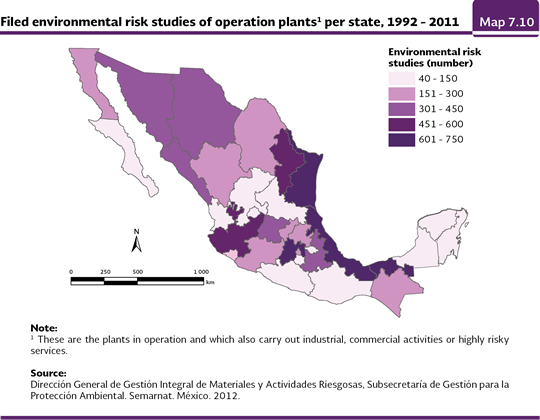
| CHAPTER 7. WASTE |
ENVIRONMENTAL RISK The General Law of Ecologic Balance and environment protection (LGEEPA) in the Chapter V, Article 146, states that for the classification of the “Highly risky activities” the following must be taken into consideration: “… the corrosive, reactive, explosive, toxic, flammable or infectious-biological characteristics (CRETIB) for the ecologic or environment balance, of the materials generated or handled in the industrial commercial or service establishments, considering, besides, the handling volumes and the establishment location” (LEGEEPA, 2012). The environment risk is defined as the probability of the occurrence of bigger accidents that involve the hazardous materials which are handled in the highly risky activities that may go beyond the facility limits and to adversely affect the population, environment and ecosystems. An activity is considered as highly risky (AAR) when it handles any of the chemical substances included in the First and Second Listing of Highly Risky Activities published in the Federation Daily Gazette on March 28, 1990 and May 4, 1992, respectively (DOF, 1990 and 1992). In this context, the risk assessment involves the determination of the possible extent of accidents and the intensity of the adverse effects in different affectation ratios. In this way, those who carry out activities considered as highly risky according to what is established in the First and Second Listings must state and file before the Semarnat an environment risk study (ERA) whose principal objective is to identify, grade and assess the risks for the handling of hazardous materials in the facilities, forecasting the possibility of accidental leaks of hazardous chemical substances in the facilities, in such a way that they may be prevented or mitigated. In the period between 1992 and 2011, 8,968 ERA were filed; the oil and its derivatives sector filed the most of them (2,417 studies; 27% out of the total of the period), followed by the food and beverages (1,230; 13.7%), chemical (1,000; 11.2%), LP gas (877; 9.8%; Figure 7.26). At a state level, Veracruz filed, during the same period, the largest number of ERA (739; 8.2% out of the total studies), followed by Tabasco (722, 8.1%), State of Mexico (686; 7.6%) and Tamaulipas (663, 7.4%; Map 7.9); in contrast, the states with the lowest filed studies were Baja California Sur (42 studies; 0.5%), Nayarit (69; 0.8%) and Zacatecas (81; 0.9%; Map 7.10; Table D3_WASTEP02_05).
The Programs for Accident Prevention (PA) establish the preventive, correction, control, mitigation and attention measures in the event of an accident in the facilities which carry out highly risky activities. They are closely related to their ERA, which are the technical support for their elaboration. During the period between 2007 and 2012, 1,906 Programs for the Accident Prevention of Operation Plants were filed before the General direction of Integral Management of Risky Material and activities (DGGIMAR); 1,578 (82.8%) were authorized and 104 were denied9 (5.5%; Figure 7.27; Table D3_WASTEP02_04).
Note: 9 The number of authorized and denied programs is not necessarily equal to the number of filed ones because, as a result of the assessment they have to go through, they may have been requested additional information, they were dismissed for not submitting the information in a timely manner, they were removed or it was ruled they are not under federal competence.
|


